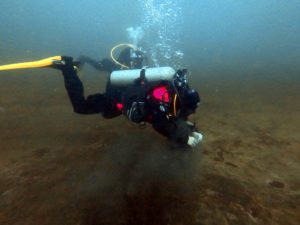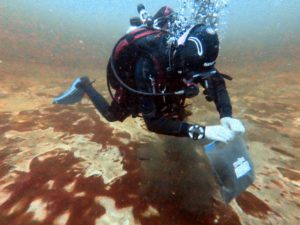This week, a group of experienced SCUBAnauts including me traveled to Alpena, Michigan to dive on the numerous shipwrecks in Thunder Bay National Marine Sanctuary. We got to do a special dive to collect cyanobacteria from an underwater sinkhole for a project in Germany.

Evana hovers just above the sinkhole floor, careful not to touch and disturb the silty bottom. The collection process inevitably disturbs the bottom, lowering visibility, so additional disturbances must be avoided.
The project goal is to understand how the earth got its oxygen. When the earth’s rotation slowed, creating the length of days that we see now, it caused more sunlight to reach cyanobacteria very similar, if not the same, as what we have in the sinkhole today. This extra sunlight allowed the cyanobacteria to photosynthesize longer each day. The photosynthesis of the cyanobacteria produces oxygen which is then expelled into the water and atmosphere. Thus, with the lengthening of days comes more oxygen being produced.
The international scientists that started this project needed our help to collect samples and ship them back due to current travel restrictions. This dive was one of my favorites that we completed on this trip.
Collection Methods
We had two pairs of divers head down about 75 feet to the bottom of the sinkhole at about 52 degrees Fahrenheit. One diver was designated the “scooper” while the other held the samples once they were collected. As I was the one scooping, I brought 1-gallon Ziplock bags down with me and searched for the mats of cyanobacteria. Once I found a patch, I would lower myself to hover directly over the bottom, which was many feet deep of silt, and try to catch the cyanobacteria in the bag.

The team at Thunder Bay has tried many collection methods over the years, but the ziplock is simplest and has produced the best, usable results.
The best description I heard was it being like trying to scoop whipped cream off pudding into a plastic bag. Each team did six or seven bags to have a total of fourteen collections. The challenging portion of this dive was the low temperature of the water. Luckily our dry suits kept us warm on our bodies, but our hands felt a little frosty. A problem was trying to function with 5mm gloves on, which seriously reduces mobility, while others went without gloves and endured the cold water.
Once we started ascending, it was a weird feeling to think that 60-degree water felt warm. Then we had to head back to shore quickly to hand the samples off as they needed to arrive in Germany as soon as possible for the scientists to analyze. Overall, I very much enjoyed this silly-feeling task of trying to catch bacteria in a bag, and it was very cool to know that we were a crucial part of a much bigger project that is happening in Germany.
— Evana F., 1st Class Naut, Tarpon Springs FL

